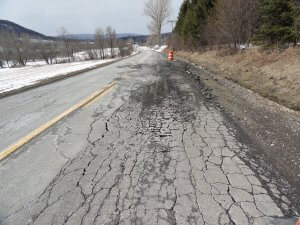In June UTC partners at Cornell’s Local Roads Program will host a free webinar on low-volume roadway pavements and how to use a new software they have developed to help local agencies do their own pavement designs.

Example of a local road segment designed too thin. Photo ©Geoff Scott, PE.
Region 2 University Transportation Center (UTC) partners at Cornell University’s Local Roads Program have developed a new software tool to help local agencies do their own pavement designs. Under-designing roads can mean more expensive repairs for local counties, towns, and villages. To address this issue, they developed RoadPE: LHI, a user-friendly excel-based software tool that uses modern mechanistic-empirical methods to assist local agencies with designing their low-volume roads (LVRs) for various types of traffic.
Join them here on June 16th from 2-3 pm for a free webinar that will review the critical inputs needed for LVR pavement design and discuss ways for local agencies to design the thickness of their LVRs including the new RoadPE: LHI software. Attendees will leave with a better understanding of what a LVR is, critical inputs needed for LVR pavement design, the limitations of a simple LVR design tool and when a more sophisticated tool is required, and having practiced using the new RoadPE: LHI software.
For many local agencies, finding the right pavement design and then gathering the resources to implement it is a pain, and an expensive one at that.
Dr. David Orr, PE, Director of Cornell University’s Local Roads Program, has been studying the problem. He said that a combination of tight budgets, localized needs, insufficient tools, and a lack of engineering support push many agencies away from doing their own specialized pavement designs — a decision that can lead to underbuilding local roads and the need for costly re-builds earlier than expected.
“The number of local agencies who actually do pavement design is nearly non-existent — most people don’t do it and yet we know they need to,” he said.
To address this issue, Cornell developed RoadPE: LHI, which was made for low-volume roads with less than 2,000 vehicles per day, and uses basic inputs that can be determined by a small highway department and other pre-calculated inputs and design assumptions to help them determine the thickness of a new asphalt layer.
Read the full story on the new software here.

